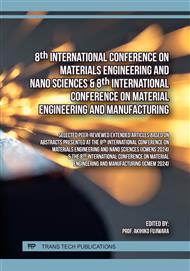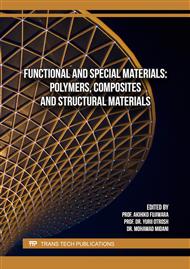p.17
p.23
p.31
p.37
p.43
p.49
p.61
p.77
p.89
Temperature-Dependence of Energy Storage and Electrocaloric Performances of Ternary PVDF-HFP/PU/PMMA Composites
Abstract:
Ternary polymer blends of ferroelectric Poly (vinylidene fluoride-co-hexafluoropropylene) (PVDF-HFP, heterostructure Polyurethane (PU) with hard and soft segments, and amorphous Polymethyl methacrylate (PMMA) has been investigated on energy storage performances and electrocaloric effect. The microstructure phase of polymer blends has been analyzed using the X-ray diffraction (XRD) technique. The frequency-dependence of dielectric properties for polymers blend has been conducted. The ferroelectric, energy storage and electrocaloric properties of polymers blend depending on temperature were studied. The result showed that the dielectric constant of PVDF-HFP@PU composite is higher than PVDF-HFP@PMMA composites due to the strong interfacial polarization effect and contribution of the polymer blend. Moreover, it was noted that the crystalline–amorphous interface properties depend on the polymer blend with PU and PMMA, resulting in ferroelectric, energy storage and electrocaloric properties when temperature increases. Therefore, the comparison based on heterostructure and amorphous structure for series polymer blends can be used to predict practical devices.
Info:
Periodical:
Pages:
43-48
Citation:
Online since:
September 2024
Authors:
Price:
Сopyright:
© 2024 Trans Tech Publications Ltd. All Rights Reserved
Share:
Citation:



